Nailor Airwaves is your source for content on relevant topics concerning Nailor Industries, Inc. and the HVAC industry. New product releases, case studies, product & project spotlights, employee interviews, trade publication articles, and general announcements are some of the content types you can expect to find in the Nailor Airwaves.
Nailor Airwaves
Air Measuring Damper
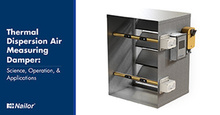
Knowing how much air is passing through a duct or entering a building is imperative in many commercial HVAC applications today but being able to control the airflow can be even more important. Throughout the HVAC industry, there already exists many innovative ways of measuring air, such as differential pressure using pitot tubes, anemometers, vortices, electromagnetic flow meters, and calculation based on damper position, yet the industry often turns to accurate and dependable Thermal Dispersion Technology. Offered as an all-in-one unit, the Thermal Dispersion Air Measuring Damper by Nailor is capable of accurately measuring the airflow using thermal dispersion probes and controlling the airflow with an actuator-modulated control damper. Featuring BACnet protocol compliance, the… Read more
Water Source Heat Pump Building Systems: Cooling Tower
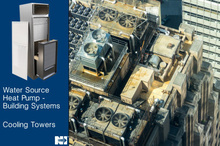
In our previous articles we highlighted the benefits, design, energy efficiency, and configurations of water source heat pump technology. Though heat pumps include a refrigeration cycle and air conditioner in one small package, they are only able to do this in cooperation with a few building systems that are critical for removing or delivering heat from/to the heat pump. To remove heat from the units the building system includes a cooling tower, and to add heat a boiler. The tower and boiler are connected to the heat pumps by a common water loop. Just like the numerous configurations of heat pump, there are several different configurations of cooling tower that can be selected for your project.
Cooling Tower
Fundamentally, a cooling tower performs the same… Read more
Water Source Heat Pump Building Systems: Cooling Tower
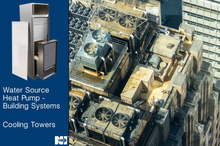
In our previous articles we highlighted the benefits, design, energy efficiency, and configurations of water source heat pump technology. Though heat pumps include a refrigeration cycle and air conditioner in one small package, they are only able to do this in cooperation with a few building systems that are critical for removing or delivering heat from/to the heat pump. To remove heat from the units the building system includes a cooling tower, and to add heat a boiler. The tower and boiler are connected to the heat pumps by a common water loop. Just like the numerous configurations of heat pump, there are several different configurations of cooling tower that can be selected for your project.
Cooling Tower
Fundamentally, a cooling tower performs the same… Read more
Water Source Heat Pumps: Configurations
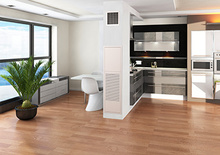
Water source heat pump (WSHP) systems have proven in many studies to be a more efficient, less complex, and higher ROI air conditioning selection for a variety of project types. These systems utilize a building loop of water to reject/draw heat into the individual dwelling unit. The benefits include no external equipment at each building unit, only one set of (possibly) un-insulated piping for the building loop, and distributed conditioning (one heat pump isn’t affected by the downtime of another). To meet the needs of different space designs the WSHPs come in four different configurations: vertical stack, horizontal, packaged, and split. Each one of these have features and benefits as well as limitations that must be considered when selecting for your design… Read more
Water Source Heat Pumps: Configurations
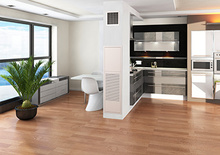
Water source heat pump (WSHP) systems have proven in many studies to be a more efficient, less complex, and higher ROI air conditioning selection for a variety of project types. These systems utilize a building loop of water to reject/draw heat into the individual dwelling unit. The benefits include no external equipment at each building unit, only one set of (possibly) un-insulated piping for the building loop, and distributed conditioning (one heat pump isn’t affected by the downtime of another). To meet the needs of different space designs the WSHPs come in four different configurations: vertical stack, horizontal, packaged, and split. Each one of these have features and benefits as well as limitations that must be considered when selecting for your design… Read more